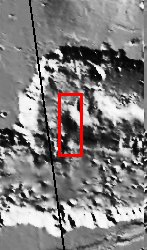- Original Caption Released with Image:
-

(Released 29 March 2002)
The Science
The Story These layered deposits are located on the floor of a large canyon called Ganges Chasma which is a part of the Valles Marineris. Dramatic layering can be seen throughout the deposit. Different styles of erosion are manifest in these different layers and at different locations within the layered material. For example, the southern portion of these deposits have a pronounced fluting, whereas in other areas the same layers are more intact. Relatively dark dunes and sand sheets can be observed surrounding the relatively brighter layered material in the upper right and lower portions of the image. Darker material also appears to mantle select areas of the layered deposits. The formation of the dunes is influenced by topography; this influence is best illustrated in the upper left of the image where a small hillock has interfered with the local wind flow. Impact craters of all sizes are noticeably absent in this image, indicating a relatively young age for this surface. This image is approximately 22 km wide and 60 km in length; north is toward the top.
The Story
If this wonderfully textured landform were on Earth, it would have to be designated as a "national park," much like the popular canyon parklands of the American Southwest. Look for the oblong plateau at the center right of this image, and see how the terrain descends from it on all sides. The southerly canyon wall (bottom third of the image) displays a visually beautiful canyon slope, with descending erosional flutes that cut pathways through the differently hued rock and mineral layers. While the northern side of the plateau might not look as dramatic, don't miss the dark-colored sand dunes that lie at the base of the canyon. Why did they form in just that place? To find out, look for the small hillock in the top left of the image that has interfered with the wind's flow, causing the ripply dunes to form. With so many interesting and physically stunning features, this spot will no doubt attract eager Mars tourists some day far in the future.
- Image Credit:
-
NASA/JPL/Arizona State University
Image Addition Date: -
2002-05-21
|

